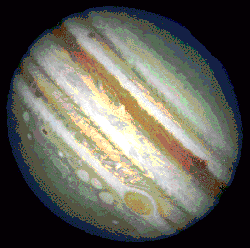
 Like most stars the Sun is a ball of incandescent gas comprised
principally of the gases hydrogen (70%) and helium (25%).
It is the conversion (burning) of hydrogen into helium which powers
stars and makes them shine. Based on the famous discovery of
Albert Einstein, that mass can be converted into energy (E=mc^2), the Sun
shines by turning matter into radiation, primarily in the form of
light. This, above all, is what makes the Sun a star. This process of
generating light from turning hydrogen into helium in the
solar interior
is called nuclear fusion and is the same process as
occurs in some nuclear power stations. In order for nuclear fusion to occur
in a star its mass must exceed a certain
value. A ball of gas will collapse under its own weight due to the
force of gravity. If the total mass of gas exceeds about 1/10th the
mass of the Sun
Like most stars the Sun is a ball of incandescent gas comprised
principally of the gases hydrogen (70%) and helium (25%).
It is the conversion (burning) of hydrogen into helium which powers
stars and makes them shine. Based on the famous discovery of
Albert Einstein, that mass can be converted into energy (E=mc^2), the Sun
shines by turning matter into radiation, primarily in the form of
light. This, above all, is what makes the Sun a star. This process of
generating light from turning hydrogen into helium in the
solar interior
is called nuclear fusion and is the same process as
occurs in some nuclear power stations. In order for nuclear fusion to occur
in a star its mass must exceed a certain
value. A ball of gas will collapse under its own weight due to the
force of gravity. If the total mass of gas exceeds about 1/10th the
mass of the Sun
 then the interior will become very dense and very hot. These conditions are
enough to trigger the nuclear conversion of hydrogen to helium. The energy
released in this process is enough to make the gas turn into a shining star. The Sun's
mass is approximately 10^30 Kg or about
333,000 times the mass of the earth. If the mass is below about 10^29 Kg,
no nuclear reactions will take place and the gas will not shine but
become something like a large version of the planet Jupiter, a giant gaseous planet.
(Jupiter's mass is about 1/1000th that of the Sun).
then the interior will become very dense and very hot. These conditions are
enough to trigger the nuclear conversion of hydrogen to helium. The energy
released in this process is enough to make the gas turn into a shining star. The Sun's
mass is approximately 10^30 Kg or about
333,000 times the mass of the earth. If the mass is below about 10^29 Kg,
no nuclear reactions will take place and the gas will not shine but
become something like a large version of the planet Jupiter, a giant gaseous planet.
(Jupiter's mass is about 1/1000th that of the Sun).
